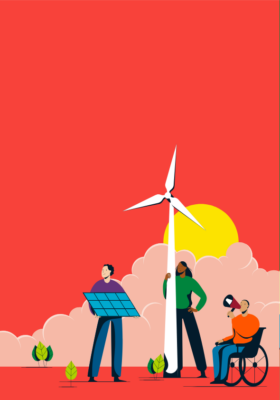Across the globe, people are reclaiming their electrical power. Communities are charting their own future by producing clean, renewable energy.
In Chad, people are putting solar panels on schools and small businesses where there is no electrical grid. In the Amazon, indigenous communities are using solar to stay independent from fossil fuel dependence. In South Africa, communities are planning transformations of old coal mines into shining solar fields that power homes and model a just transition away from fossil fuels.
Our Own Power is a network of people increasing our own power in our communities. We are rejecting the primary driver of the climate crisis: the fossil fuel industry. Instead, we are redesigning structures and turning to community-driven solutions. Join the movement!
The road to Our Own Power is not always easy. It takes time to build connections in many of our communities. There are technical and financial challenges — the tips in this booklet can help. And there may be national or local regulation that cannot be overcome by a single community effort. Like in Turkey, cooperatives preparing to build out solar projects found burdensome regulatory hurdles. So they are tackling not only the task of building a community plan but also bigger policy battles. Find other allies and network on the Our Own Power website.
Creating these community energy projects has huge benefits. Communities get cheaper, stable electricity. Projects generate positive health impacts — reducing pollution from diesel generators or coal-fired power plants. The community is stronger, more educated, and grows in its sense of pride.
Providing a direct service that benefits your community can speak louder than any rhetorical argument. This can build lasting public support for more substantive changes for a low-carbon energy landscape against fossil fuels and pro-new renewable energy projects.
And this is why we do this together. Our Own Power is a network of people working on this together. Our local scale may not be big enough to change the entire world’s energy systems on our own, but as a global group we are a force to be reckoned with.
You can contribute to overcoming energy poverty, stabilising electrical prices, reducing pollution, fighting climate change, and bringing your community together for a project they can be proud of —
If that sounds like a good plan, then read on and join Our Own Power!
ABOUT THIS TOOLKIT
“As they go lower and lower, we need to shoot higher and higher.”
– Naomi Klein, No Is Not Enough: Defeating the New Shock Politics
We hope this inspires and supports you to build your own local renewable energy projects. You can do it — but it’s hard work! The toolkit is divided into different phases to implement community-led renewable energy projects. You can start at any of the phases, depending on where you are.
COMMUNITY-LED RENEWABLE ENERGY PROJECTS
“Remember this: We be many and they be few. They need us more than we need them. Another world is not only possible, she is on her way. On a quiet day, I can hear her breathing.”
― Arundhati Roy, War Talk
Everyone has a role in the fight against climate change and we need to create ways to bring our communities to the fight of our lives. We need to build life-changing solutions with people from around the globe that have a real impact on averting the worst climate scenarios. And we can work from where we are, with our communities, with our people.
Why community-led?
The more that neighbourhood associations, cooperatives, schools, religious institutions, municipalities, or other community groups take control of the energy system, the more we collectively shift power from the fossil fuel industry’s polluting influence on our politics and make it clear to politicians that they need to be accountable to their citizens in planning our energy future.
Community-led renewable energy can contribute to decarbonising our energy system, but also decarbonising our political system.
The benefits of renewable energy projects led by communities are countless:
Environmental Benefits
- Lifts the environmental burdens placed on communities by the traditional fossil fuel-based industry
- Helps reduce greenhouse gas emissions and related climate change impacts
- Increases energy efficiency and minimises the loss of electricity through long-distance transmission
- Increases community awareness of energy use and its localised impacts
- Greater conservation and sustainable energy behaviour
- Reduces impacts of the extractive energy industry by decreasing or eliminating fossil fuel energy use.
Economic Benefits
- Price certainty and stability, since renewable energy like wind and solar are zero-cost fuels
- Economies of scale; community-scale renewables are less costly per Watt of capacity than individual arrays
- Helps keep money invested in the local economy
- Job creation in the host community
- Adds new technical skills to the community skill base
- Reduces local economic dependence on dirty energy sources.
Social Benefits
- Gives community members the opportunity to take control of the planning, development, and maintenance of energy
- Ensures that energy systems are designed to maximise public and community benefit
- Improves community resilience and gives the community control over their own energy production and distribution
- Increases energy accessibility
- Advances community self-determination and allows community members to advocate on their own behalf
- Increased democracy by shifting revenue from fossil fuel companies that have used profits to suppress civil rights into the hands and control of communities.
Bullet list edited from NAACP Toolkit: Just Energy: Reducing Pollution, Creating Jobs Toolkit
Accelerating a just energy transition
Putting our communities at the centre of building our own renewable energy projects implies updating the way we produce, distribute, store, and use our power as part of a bigger change in the social, political, and economic system, by offering an unprecedented opportunity to simultaneously tackle the climate crisis and reduce inequality.
The climate crisis is intensifying. More frequent and intense extreme events are devastating millions of lives, disproportionately affecting marginalised communities and social groups who have contributed the least to the climate crisis. A just energy transition is urgently needed to reduce carbon emissions and prevent the impacts from worsening.
We need to shift from an economy heavily reliant on fossil fuels to one that is based on renewable and sustainable energy sources in a manner that is equitable, inclusive, and considers the needs and rights of all stakeholders, particularly vulnerable and marginalised communities.
Our Own Power is rooted in the understanding that transitioning to a low-carbon and sustainable energy system is not just an environmental imperative but also a social and economic one.
These are some of the key principles and guardrails to ensure just and equitable renewable energy:
| Energy Justice: | Addressing energy poverty and ensuring that energy access is not only universal but also gender-sensitive, equitable, and sufficient to meet the basic needs of all people. |
| Efficiency and Equity: | Curbing wasteful and excessive, unnecessary energy use, while providing sufficient energy to all people within and across countries – across production and consumption. |
| Transparency and Inclusion: | Crafting energy systems that are transparent, democratic, and free from discrimination while championing energy sovereignty, local ownership, and the fostering of dignified employment. |
| Sustainable Resource Stewardship: | Upholding well-managed usage and safeguarding of land, water, and marine resources. Recognizing and safeguarding ecologically sensitive areas, as well as prioritising and establishing policies around prime agriculture and water resources for food and health. Addressing any harm through remediation and responsible governance. |
| Mitigating Resource Extraction Impact: | Diligently working towards minimising the necessity for, and consequences of, extracting critical minerals indispensable for the renewable energy transition through policies and regulatory systems over the extraction, mining, processing, and trade. Upholding principles of circular solutions and reducing raw materials usage. |
| Guardianship of Rights and Participation: | Upholding and preserving essential human rights, including the Right to Free, Prior, and Informed Consent of Indigenous Peoples and facilitating participatory decision-making. |
| Safeguarding Ecological Vitality: | Ensuring ecological preservation, regeneration, and restoration of biodiversity and ecological integrity by recognizing ecologically sensitive areas and prioritising sustaining essential ecosystems of conserved areas above energy generation, conducting regulatory environmental impact assessments of areas for energy development, and when unavoidable impacts occur, set mechanisms to regenerate and restore ecosystems. |
| Financial Equity and Climate Responsibility: | Ensuring adequate and just climate financing from wealthier nations, without burdening lower-income countries with new debt stemming from investments in renewable energy. When private funds are mobilised, regulations to ensure transparency, fairness, adherence to social and environmental principles, and affordability must be in place. |
Excerpt from: 350.org (2023). Power Up for Climate Justice: Financing and Implementing a 1.5°C Aligned Global Renewables Target.
The pressing need for renewable energy
The implementation of new renewable energy projects and energy efficiency are the most vital alternatives, by far the largest short-term and mid-term technological cost-effective options, to substitute fossil fuels to prevent ever more dangerous climate impacts.
More than 80% of the world’s energy still comes from burning dangerous fuels like coal, oil, and gas despite the growing momentum behind a fast and fair transition to 100% renewable energy economies.
Globally, we need to reach a yearly instalment of, on average, at least 1.5TW renewable energy from 2030 onwards to keep global temperature at 1.5°C, which represents a threefold increase from 2022 levels.
Fighting for renewable energy projects is crucial to avoid worsening climate change due to a list of reasons:
Significant reduction of greenhouse gas emissions limiting the global temperature rise and alleviating the climate impacts on vulnerable communities. Solar, wind, hydro, geothermal, produce little to no greenhouse gas emissions during their operation.
Ensuring energy security and access since these resources are abundant and locally available in most regions.
Contributing to better public health by significantly reducing air pollution from burning fossil fuels as the major cause of respiratory illnesses, heart diseases and premature deaths.
Stimulating the emergence of a regenerative economy by developing technologies and creating greener jobs, and also influencing various other sectors.
Helping governments meet their international commitments like the Paris agreement, which would lead to more pressure on other countries.
To build the renewable energy infrastructure, firmly rooted in the context of climate justice, we have to work on mutually reinforcing strategies on several levels:
| Creating visionary narratives | Building community-led initiatives | Building local adaptation projects | Campaigning for national policies | Campaigning for international policies | Confronting false solutions | Stopping the bad (keep it in the ground) |
| Showing what we are “for” and not just against — by lifting up the solutions that bring us closer to justice | Putting the community in the driver’s seat of the solutions most needed and into the hands of people across the globe | Following the leadership of communities bearing the brunt of the climate crisis to prepare for the changing climate | Bringing moral and political weight to leadership to create and implement ambitious policies and generous subsidies for the expansion and growth of RE | International stakeholders getting pressured to make their statements meaningful granting the conditions for greater implementation and funding of RE globally | A framework to confront the false solutions that are running around and to recenter movement energy on the solutions that matter | A wide set of actions to keep fossil fuels in the ground and making them unprofitable and morally unacceptable — from lobbying, persuasion, to direct action |
To make this pressing need for renewable energy a reality, we need:
Visionary political will and ambitious policies
- for creating generous subsidies and regulations for the expansion and growth of wind and solar power (i.e. lowering the upfront costs of RE implementation and costs of maintenance);
- for promoting energy efficiency standards;
- for raising carbon taxes to make fossil fuels more expensive.
Investment in technological innovation and expanding access
- for the development of new technologies for solar and wind power, which helps drive down the costs of RE, create a reliable supply chain, and new jobs;
- for creating smart grid technologies allowing the integration and storage capability of large amounts of wind and solar power without disrupting supply
- for resources to expand access to renewable energy projects.
Community involvement
- for communities leading the implementation of RE projects and getting direct benefits from the power they generate;
- for building public support for a larger RE infrastructure and increasing the number of new projects.
And we cannot do it all! Each of us selects what pieces we want to tackle.
The aim of this toolkit is on building community involvement and power coming out of the communities to create local renewable energy projects and put pressure on the other aspects to promote a large-scale rollout of renewable energy from a climate justice perspective across the globe.



